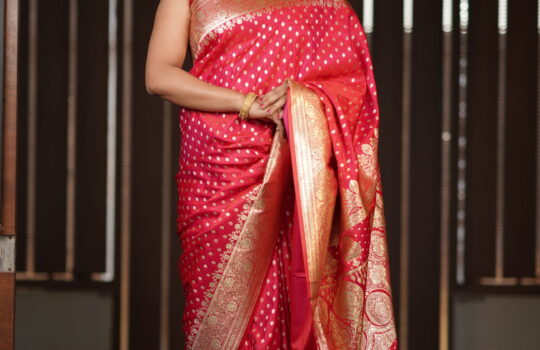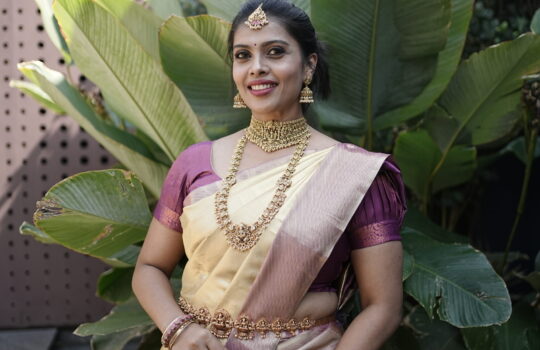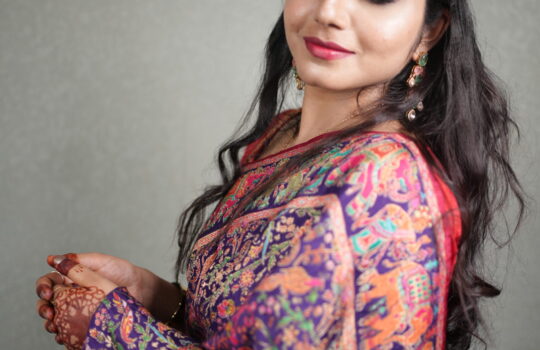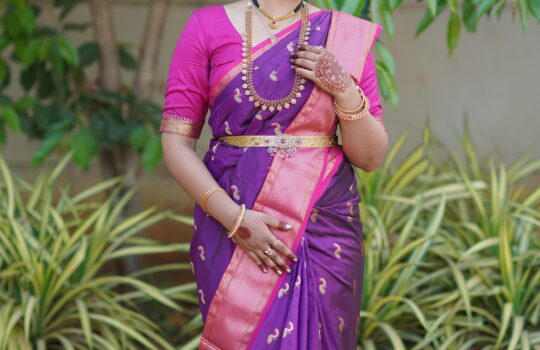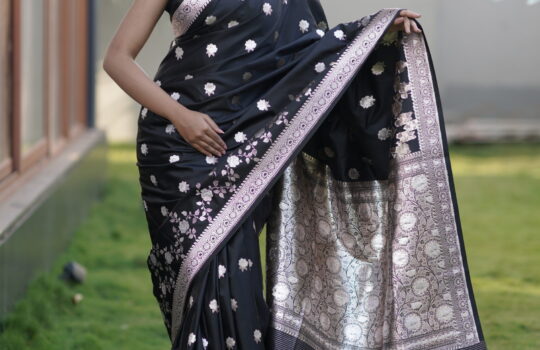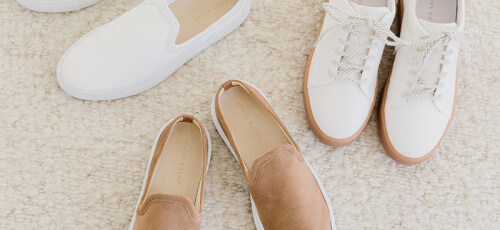A saree drape refers to the art of styling and wrapping a saree, a traditional garment worn primarily in India. This tradition dates back centuries of cultural history; each region offers their own style of draping a saree. Typically crafted from 6-9 yards of fabric, the saree is draped around the body to combine elegance, comfort, and cultural heritage in an attractive fashion. The Nivi style is its most well-known form involving pleats at the waist with the pallu elegantly draped over one shoulder. Regional drapes such as those worn by Bengalis, Maharashtrians, and Gujaratis feature unique variations in how their pallus is styled and pleats arranged – each style reflecting customs and traditions specific to that region. Over time, saree draping has evolved with fashion trends and modernized to meet modern tastes; including popular contemporary styles such as pant sarees, cape sarees, and lehenga sarees for an eye-catching modern take. A saree drape is more than just an accessory; it encapsulates your personal style, cultural identity, and event. Be it worn for weddings, festivals or casual outings; its beauty remains undimmed.
Some Of The Saree Drapping Techniques
Traditional saree drapes like the Nivi Style, Bengali and Maharashtrian styles are timeless yet culturally-rooted ways to wear the saree gracefully and elegantly. These styles often involve pleating fabric at the waist before draping it across your shoulders according to regional customs and customs. Modern variations like pant Style, cape Style or Lehenga Style provide contemporary twists while still upholding tradition’s timeless charm.
A wedding saree is a traditional and important garment in many cultures, especially in India. To know more visit
WEDDING SAREE : TOP 10 MUST HAVE WEDDING SAREE
Best Saree Store In Hubli : Preeti Silks
Silk Saree In Hubli : Top 5 Silk Saree’s That Must Be In Your Collection
Nivi Style
The Nivi Style is one of the oldest and best-known methods of draping a saree, hailing from Andhra Pradesh in India. This timeless way to wear a saree has become the standard at weddings, formal events and festivals across the globe. Start off this look by tucking one end of the saree into your waistband, then wrap it once around your body. Pleats should then be added neatly along the front edge before being tucked back into your waistband for an attractive structured finish. The Nivi Style is a simple yet elegant way to wear the loose end of a saree around one shoulder, leaving it to fall down gracefully towards either back or front. This style can be altered easily through variations such as pleating the pallu. Many women across India and around the world turn to this elegant yet comfortable choice as an everyday look.
Bengali Style
The Bengali Style of draping a saree is an iconic and traditional method that originated in eastern state of Bengal. Renowned for its graceful yet distinctive appearance, this style can often be found during cultural festivals such as Durga Puja or traditional Bengali weddings. For this style of draping, the saree must first be tucked into its waistband at the back, and then draped around the body forming pleats at its front. Bengali style is distinguished by the pallu, which is draped across the front of the body and then over the left shoulder in a bold yet symmetrical fashion, creating a striking, eye-catching appearance. Pleats often arrange at the back, setting this style apart from Nivi style. The pallu, often beautifully decorated or embroidered or patterned, is typically worn with either a blouse known as choli or bandhni for added sophistication; its drape also represents its rich cultural history and sophistication of Bengal.
Maharashtrian Style
The Maharashtrian Style of saree draping is an enduring tradition from Maharashtra that showcases their region’s cultural identity and can often be seen at festivals like Gudi Padwa or weddings in Maharashtra. The saree is draped around the waist with its pleats neatly tucked behind, creating a fluid look. A signature characteristic of this style is the pallu* draped across one shoulder and often pinned or tucked at this location. What distinguishes this style is the Kasta knot, a unique tie at the waist that secures the saree in place and also drapes its pallu around the body to create layers. This style usually pairs well with traditional blouses such as navaris that include ornaments like nose rings (nath) and bracelets; exuding both elegance and cultural significance with each draped layer.
Coorgi Style
The Coorgi Style of saree drape is an age-old tradition from Coorg, an area in southern India known for its distinct culture and heritage. Kodava women predominantly wear this style on special occasions like festivals or weddings to show their cultural pride. The Coorgi drape is distinctive in that it combines elements from both Maharashtrian and Kerala styles. The saree is draped from behind with pleats formed at its front edge before its pallu is draped over one shoulder as traditional methods require. Coorgi style differs significantly in that the pallu is pulled across the body and tucked in at either waist level or pinned onto shoulders for a neat, graceful appearance. Sarees may also be worn with blouses that complement them for added style and sophistication – this simple but elegant approach to Coorgi customs and traditions.
Pant Style Saree
Pant Style Saree Drape is an innovative take on traditional saree drape, combining comfort with contemporary fashion. Originating as an amalgamation of Eastern and Western influences, this style caters to women seeking both elegance and practicality in one garment. This style features the saree draped over trousers or leggings instead of the traditional petticoat, providing more freedom of movement and creating a chic look. Similar to Nivi style drapes, pleats at the front can be found while its pallu is draped languidly over one shoulder. However, the key difference lies in its bottom half; where saree is tucked over trousers to form an elegant yet practical silhouette. This modern style makes a chic yet practical choice for casual events or day outings as well as modern weddings; offering stylish yet practical alternative to traditional saree draping techniques.
Lehenga Style Saree
Lehenga Style Saree is a contemporary fusion drape that marries the elegance and style of both sarees and lehengas for an altogether distinctive and stylish look. As a modern take on traditional saree draping, this style is ideal for brides, bridesmaids and anyone attending festive events and weddings. Draped similar to lehenga skirt draping techniques, pleats tuck into this lehenga skirt instead of being pinned outward like in traditional saree drapery techniques. A saree’s pallu should then be draped over one shoulder, often featuring pleats or being left flowing for dramatic effect. This style eliminates pleating at the waist for a free-flowing and graceful appearance. This elegant combination of saree elegance and lehenga flair makes the lehenga saree drape the ideal ensemble for weddings, receptions and other large celebrations. Not only is it fashionable, but also practical: providing comfort while maintaining the traditional charm of a saree saree.
Cape Style Saree
The Cape Style Saree Drape offers a contemporary yet chic take on the traditional saree, featuring an ingenious cape as part of its drape. Ideal for bold yet sophisticated individuals looking for something bold yet graceful at once, this look features elegant fabrics while still exuding timeless charm. A traditional style saree drape is employed, with pleats tucked into the waist and the pallu over one shoulder. However, what defines cape style is its signature feature–a fashionable and often embellished piece of fabric which drapes across shoulders, arms, and down back to form an “umbrella effect”. This style can be tailored from fabric similar to the saree itself or with different materials like chiffon, georgette or lace for an eye-catching contrast. Perfect for evening events such as cocktail parties and fashion shows; offering chic modern aesthetic while still adhering to tradition saree draping techniques. A great choice for women wanting a glamorous and fashion forward saree look.
Saree with a Belt
The Saree with a Belt is an elegant and sophisticated variation on traditional saree draping, intended to add an edge and structured appearance. In this style, pleats tuck at the waist while the pallu drapes gracefully across one shoulder. However, what sets this style apart is its use of a wide belt at the waist. This belt helps define and cinch in the silhouette for a more defined silhouette while adding an air of sophistication. This style can often be accessorized with fashionable or embellished belts made of materials like leather, metallic, or fabric to complement its fabric. Belted sarees offer a distinctive, fashion-forward style suited for cocktail parties, evening events and modern weddings. Not only will the belt add style, but also ensures that the saree stays put to create a sleek and structured finish.
Ruffled Saree Style
The Ruffled Saree Style is an inventive and modern take on traditional saree design, distinguished by ruffled edges along its hemline or pallu. This drape adds an eye-catching, dramatic and textural aesthetic to a saree, making it the ideal choice for those seeking to make an eye-catching style statement without losing its timeless elegance. Ruffled styles of saree draping usually follow a classic model–pleats tucked at the waist, and pallu draped across shoulders. However, its distinguishing feature is its distinctive use of ruffles which are sewn onto either the pallu or bottom hem to create an eye-catching flowing, layered appearance. Fabrics such as chiffon, georgette or organza work well for creating this style and can help enhance ruffle movement further. A ruffled saree drape can make for an eye-catching statement at casual parties, festive occasions or semi-formal events, providing a chic modern edge on its predecessors.
Dhoti Style Saree
The Dhoti Style Saree Drape is an eye-catching and daring spin on traditional saree draping, inspired by Indian menswear known as dhotis. This style marries grace of saree drapery with functionality of dhotis to produce a contemporary and striking appearance. The saree should be wrapped around the waist, with fabric pulled between legs and tied at back resembling a dhoti. Pleats should then be arranged at front while pallu draped over shoulder in usual fashion. The end result is an eye-catching mix of traditional and contemporary elements, offering both style and comfort. This drape allows for easy movement, making it the ideal look for festivals, modern weddings, or fashion-forward events such as fashion week. Additionally, its distinct and trendy nature make the dhoti saree an appealing choice for women looking to experiment with bold styles while keeping their elegance.



